History
Construction
The Royal Netherlands Navy light cruiser Hr.Ms. De Ruyter was laid down on September 16, 1933 at the Wilton Fijenoord dockyard. She was launched on March 11, 1935 and commissioned on October 3, 1936 under Captain A.C. van der Sande Lacoste. In 1937 the ship was stationed in the former Dutch East Indies, where it was when World War II broke out.
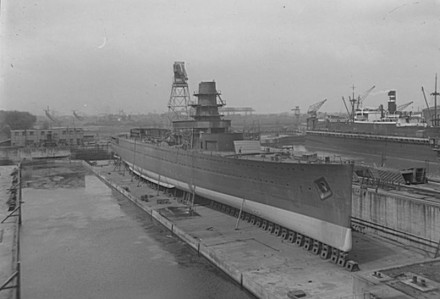
She was intended for the defense of the colony and originally designed as a 5000-ton ship with a lighter armament, but due to the cost-cutting policy that went into her design, De Ruyter would prove not to be up to the task. Especially the ship's main battery of seven 150 mm guns was considerably underpowered compared to other ships of the time.
Battle of the Java Sea
After the beginning of the war, the allied fleets in Asia started working together. The Battle of the Java Sea (February 27-28, 1942) was an effort of the allied Combined Striking Force (Australian-British-Dutch-American, ABDA) to prevent the invasion of the Dutch East Indies by the Eastern Invasion Force of Japanese Imperial Navy. The Combined Striking Force was under command of the Dutch rear admiral Karel Doorman. Because of this title, he became known as Admiral Doorman amongst the allied forces.

The ABDA force consisted of two heavy cruisers (HMS Exeter and USS Houston), three light cruisers (Hr.Ms. De Ruyter (Doorman's flagship), Hr.Ms. Java, HMAS Perth), and nine destroyers (HMS Electra, HMS Encounter, HMS Jupiter, Hr.Ms. Kortenaer, Hr.Ms. Witte de With, USS Alden, USS John D. Edwards, USS John D. Ford and USS Paul Jones). The battle consisted of a series of attempts by Doorman's Combined Striking Force to reach and attack the invasion convoy; each was rebuffed by the Japanese Naval escort force with heavy losses being inflicted on the Allies.
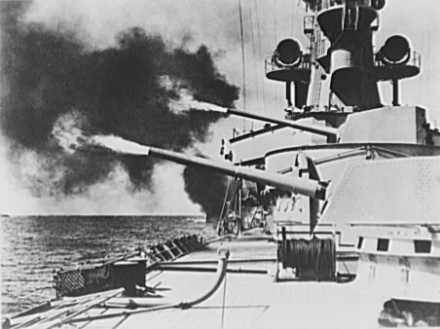
The battle began around 16:00. Although the fleets were equally matched in numbers, the Japanese cruisers had better firing range and armour. In the first phase of the battle, the cruiser Exeter was hit and the Kortenaer was sunk by a torpedo. The Jupiter ran onto a mine and sunk. By now Doorman's command was reduced to four cruisers.
A documentary by the NIMH (Dutch Institute for Military History) on the Battle of the Java Sea.
Sinking of the De Ruyter
At 23:00 they found the Japanese Fleet for the second time. Both sides exchanged fire in the darkness at long range. In this engagement the De Ruyter and the Java were sunk by torpedoes. The 168 m long ship disappeared into the waves along with 345 of its men, including Rear Admiral Doorman who chose to go down with his ship. The Japanese invasion fleet was delayed, but not prevented from making a landing on Java. Another four allied ships were sunk during the battle, which factually eradicated Dutch presence in South-East Asian waters and marked the end of the Dutch colonial age. The surviving cruisers, Houston and Perth, were sunk on the evening of the same day as they attempted to withdraw to Ceylon.
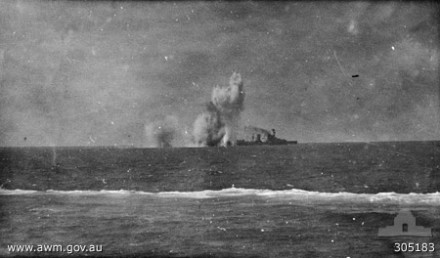
Survivors
109 survivors of the De Ruyter were taken as prisoners of war. Two people on board were doubly fortunate; sailor Klaas Leendert de Bruin was rescued by an unknown ship and the American Marvin Edward Sholar was rescued by the USS S-37.
In total, over 1.000 allied troops died in the battle, compared to about ten Japanese. This discrepancy is mainly attributed to the superior air support of the Japanese fleet.
Description
Yard: Wilton Feijenoord, Schiedam, the Netherlands
Class: De Ruyter class light cruiser
Propulsion: 3x Parsons geared steam turbines, 6x Yarrow boilers
Armament:
7 × 150 mm guns in 3 double and 1 single tower
10 × 40 mm Bofors anti aircraft gun
8 × .50 and 12,7 mm Browning machine guns
2 × Fokker C-11W seaplanes.
1 × catapult
It was laid down on December 16th, 1933 and launched on March 11th 1935. The ship was commissioned on October 3rd 1936 built in 1933, launched March 11, 1935 and commissioned October 3, 1936.
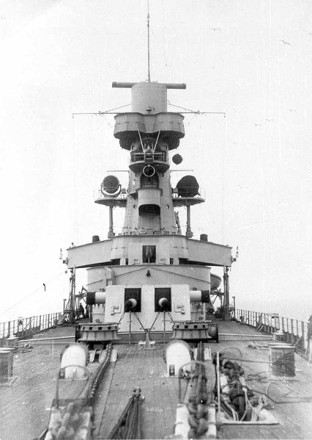

| Master | Karel Doorman |
|---|---|
| People on board | 437 |
| Power | 66000 hp |
| Speed | 32 knots ~ 37 mph (59 km/h) |
| Length | 560 ¾ feet (170.9 m) |
| Width | 51 ½ feet (15.7 m) |
| Draft | 16 ¾ feet (5.1 m) |
| Displacement | 6442 ton |
Status
Discovery
On December 1st, 2002, two cruisers from the battle, (De Ruyter and Java), were found in the Java Sea, near the island of Bawean. An international group of divers looking for the Exeter stumbled upon the De Ruyter during a search with sonar. The ship was at a depth of approximately 69 meters, heeling slightly to starboard.

Divers were able to confirm that it was indeed the De Ruyter. The discovery received little attention outside diving circles, but once again made the news in 2004 when four ship's bells were stolen from the De Ruyter and the Java and offered for sale.
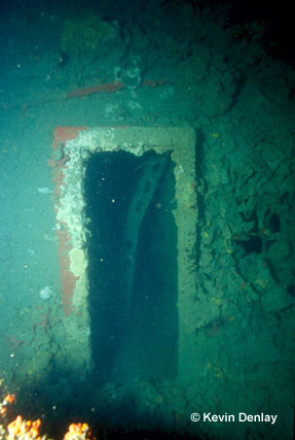
At present, the Royal Netherlands Navy owns the ship's bells again. One of the bells has been placed in Surabaya on the Karel Doorman monument. Two bells are in Den Helder, in the Naval Museum and in the Command building 'De Admiraliteit', and the fourth bell is on loan to the Kloosterkerk museum in The Hague.
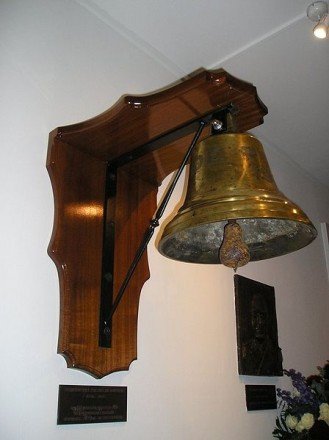
Salvage
The De Ruyter is a war grave and is designated as an 'historic shipwreck' on official nautical charts. Unfortunately, this designation has not been able to protect it from looting. In 2016 it was discovered that the wrecks of the De Ruyter and the Java, and a large part of the Kortenaer, had disappeared from the seabed, though their imprints remain. During a meeting on November 23rd 2016, president Widodo of Indonesia and Prime Minister Rutte of the Netherlands agreed that both countries would cooperate to research what had happened and to better preserve their maritime heritage in the future. A three-tracked approach was agreed upon by both governments:
- Verification of the disappearance;
- Appreciation of what had happened; and
- Future cooperation to manage remaining maritime cultural heritage.
For more information on this joint Dutch-Indonesian research can be found in the publications under references and here. It is assumed that the ships have been illegally salvaged because of the iron from their hulls. The iron of this type of ships is very valuable and sought after. It is of an unusual quality since it has been made before nuclear weapons were detonated in the atmosphere from 1945. Because of this, the steel has not been subjected to radioactivity during its production and it has a low background radiation - making it useful for specialist measuring equipment amongst other things.
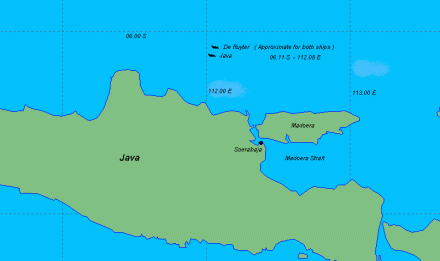
References
- Report of the Dutch Shipwrecks in the Java Sea.
- M.R. Manders/R.W. de Hoop/S. Adhityatama/W.A. Barten/B. Budi Utomo/O. Dwiyana/A. Kusno/J. Rechar & Z. Tahir (2017).
Joint Verification of the location and condition of Hr.Ms. De Ruyter, Java and Kortenaer. - M.R. Manders & R.W. de Hoop (2018).
Battle of the Java Sea: Past and Present Conflicts. - M.R. Manders, R.W. de Hoop & Shinatria Adhityatama (2019).
Field Assessment Java Sea Survey of three Dutch WWII naval wreck sites in the Java Sea, Progress Report. - S. Lovegrove/R.W. de Hoop/S. Adhityatama (2020).
Good practice: international collaboration on shared difficult heritage.
Sharing Heritage Expertise nr. 13. - M.R. Manders/R.W. de Hoop/S. Adhityatama/D.S. Bismoko/P. Syofiadisna & D. Haryanto (2020).
Battle of the Java Sea: One Event, Multiple Sites, Values and Views.
Journal of Maritime Archaeology 2021. - Hr. Ms. De Ruyter.
- Karel Doorman.
- The Battle of the Java Sea.
- Australian War memorial.
- RCE.
Artefacten van scheepswrakken Javazee naar Nederland overgebracht.